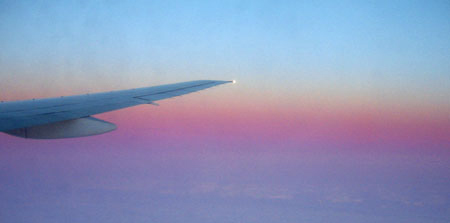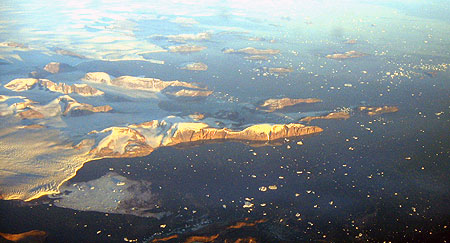Ultima Thule (Idle Words)#
10.01.2006
 /
/
I paid a brief visit home two weeks ago, flying to New York in a plane carrying at least twenty newly-adopted Chinese babies, who cried in shifts. I could hardly blame them, though in the end I wished I could join them. The flight is thirteen hours long and from the middle of coach class has almost nothing to recommend it. Coming home, though, I got a window seat - one of my fondest dreams coming true. I would get to see the North Pole!
These polar routes from New York to China are a recent miracle, a function of better navigation, increased air traffic to Asia, an unusually relaxed attitude by the FAA and Russia's decision to stop shooting down airliners that cross into Siberian airspace. There were some test revenue flights in the late 1990's, but it's only in the last few years that cross-polar routes have become standard.
I had flown over the pole twice before, each time seated in the exact center of the airplane with plenty of time to nourish my hatred for in-flight mapping software and the Mercator projection, both of which are at their worst on long-haul flights to Asia. Why do I need to see the outside air temperature in Chinese every thirty seconds? But in a window seat, all worries melt away.
The 777 takes off with the usual grace and speed of fraternity brothers trying to move a heavy sofa, but soon the plane is airborne and you have that stupendous view of the New York City skyline to gawk at. Within an hour the plane has entered Canada from Vermont - a strange glimpse of seven years of my life - and then it is overflying the crooked boomerang of Montreal, the big Manicouaga circle crater and the endless forests of northern Quebec.
Canada is extravagantly large and a flight to China is a good way to convince yourself of this. The forests last for hours, transected by enormous rivers without a hint of human settlement on them. These eventually give way to tundra, and then the land breaks up into large islands leading in to the Arctic Ocean. This is where you begin to see the icebergs.

They start up near Baffin Bay, and look just like the drift ice downstream from a glacier except that instead of the size of a building they are the size of a city block. Soon enough the culprit itself comes into view - Greenland, with its numberless glaciers all flowing down from the ice cap down and littering ice into the sea. In places the translucent ice sheet itself has been blown free of snow; you can actually see the faint color of the underlying rock through it. In three dimensions and through clear air it is absolutely transfixing.
I was particularly struck by the total stillness of the ocean, so that each peak along the coastline formed a double cone, bright orange on one side. It was past the equinox but over northern Greenland the sun was still just visible above the horizon, lighting up the ice floes and red hills, and making even the slightest rise in the snow pack cast an extravagant purple shadow northwards. As the plane headed further north, first the ground and then the sky began to deepen.
One of my favorite books contains an exact chronology of the complicated color transitions that accompany a sunset. I have tried on a couple of occasions to sit outside and follow them with my own eyes, though it is surprisingly difficult to take everything in. For anyone who doesn't live in a city he experiment makes a nice way to spend a summer evening, sitting outside with a six-pack from a half hour before sunset to an hour after twilight, trying to spot the green flash or the zodiacal light or the moment when the earth's shadow races into the sky. Near the poles these normally evanescent changes in light become frozen in place, and the plane takes you through them frame by frame, at a stately eight miles a minute, a slow motion version of what we ignore almost every night.
The sky at the very top of the world the sky glows in a series of colors that are similar to pink and lavender in the same way that Little Richard is similar to Pat Boone. I craned my neck to try and see stars at the zenith, but the window wouldn't let me look up that high. Down below I could still see the ice, now covering the ocean as an unbroken sheet, except for long parallel fissures that run for dozens of kilometers, sometimes revealing lines of dark water far below the ice. They look like a giant child had been making train tracks in his mashed potatoes with a fork.
If you are a package of avionics software, the North Pole is a stressful place. Depending on how close by you pass, longitude and bearing can change extremely quickly (or converge into an unlucky singularity) and most autopilots throw up their hands and enforce a special wings-level lockout flight mode within a few miles of the pole, to keep from spiraling around it like a housefly circling a light bulb. Radio and satellite systems don't have an easy time here, either. Most communication satellites orbit near the equatorial plane, down below the horizon, so a lot of the usual navigation and air traffic control links become useless. Meanwhile, the same charged particles that are zipping so copiously through the crew and passengers can also badly disrupt radio communication, to the point where sometimes the polar routes become unflyable.
There is also the question of the fuel in the wings turning into jelly. Jet fuel is a mix of many hydrocarbons without a sharply defined freezing point, but given enough time in the deep freeze it will start to congeal like paraffin dripping from a candle. Below -47 degrees centigrade, jet fuel starts forming waxy crystals, and after a while grows too thick for the fuel pumps to move, creating a negative passenger experience. There are ways to remedy this in flight, but it's perfectly possible to imagine a diversion to an airport like Yakutsk ( -60 C in the winter) that would require the aircraft to wait until spring before being able to take off again.
That none of this harshness poses a real risk is a little bit amazing, and also a little bit of a letdown. As we flew over the fluffy landscape of Greenland I thought how peaceful it would be for the engines to cut out and the airplane to glide silently to a belly landing on the snow. Two hours of quiet shivering, perhaps one final defiant beverage service, and the whole thing would be over. I couldn't think of a more ideal way to go, a planeload of us frozen in place watching that slow sunset. But of course there was no hope at all, the engines purring along at their inhuman levels of reliability.
I slept for a few hours above the northern ocean, waking up to see Siberian tundra and then the last wonder of the trip, subject of a thousand schmaltzy Russian campfire songs, Lake Baikal. "The deepest freshwater lake in the world!", Russians will declaim with the same gleam in their eye Chinese people get when they say "five thousand years of history!". It is certainly a beautiful thing to see from above, especially since strict visa rules make it an unreachable place for me from China. South of the lake there is an abrupt mountain range, Mongolian desert, and then a descent into the aerosols of Beijing. "We're told that visibility is clear, which in Beijing usually means 'extremely hazy'," the captain explains over the intercom. Then the plane descends into the soup, and I'm back on Chinese soil while still sucking on a poppy seed from a fresh bagel I ate that morning (night?) in New York.
The unreality of jet travel continues to unsettle me. One moment you are in one place, and hours later you have crossed the most insuperable physical barriers by flying high in the atmosphere at nearly the speed of sound, and no one finds this unusual. The sun is over the wrong horizon, everything is different, but life goes on around you like nothing has happened.
Passing over the North Pole hardly helps make the experience less dreamlike. Such flights were a novelty even into the 1950's; it's only within the last twenty years that routine passenger service over the Arctic have become technically possible, but already people are able to pull down the window shades and calmly watch the DaVinci Code or even just sleep through the whole spectacle. It makes me wonder if there is anything we can do to help our world recover its former vastness.